QUEBEC, Canada—Around 20 participants between the ages of 21 and 35 from the United States and Canada arrived at Auberge du Mont-Lanaudi?re in Saint-Gabriel-de-Brandon, Quebec, on June 30 for ArtLinks 2016, a four-day arts retreat organized by the Hamazkayin regional boards of the East Coast, West Coast, and Canada. The program promised to deliver five engaging workshops run by experts in their respective fields covering film, theater, journalism, leadership, and mythology. Participants, workshop leaders, and organizers emerged from the weekend having gained so much more—from newly gained knowledge to an immersion in the arts and, more importantly, an opportunity to engage with others who have an appreciation for the exploration of the arts and of Armenian culture.
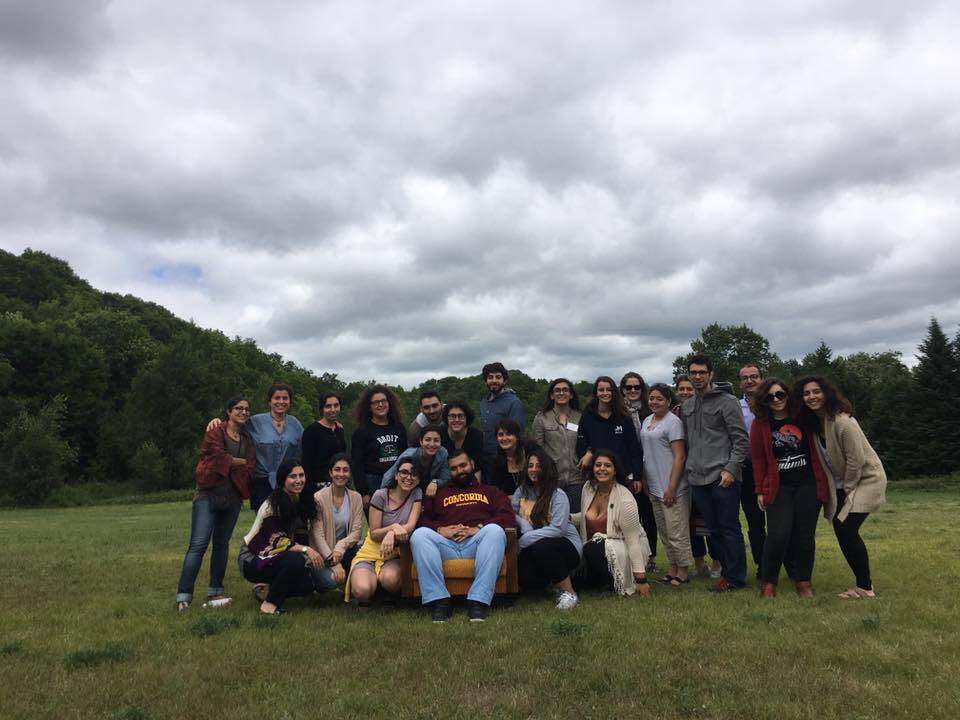
A group portrait in the field
“ArtLinks was incredible—an amazing weekend of great people, limitless conversation, and a reminder that as the future leaders in our communities we can be the beginning of change! This was a weekend that I won’t forget,” said Helena Bardakjian, a participant who hailed from Detroit.
Upon arriving at the retreat, the participants were given folders containing information, ArtLinks tees, and a room number. Once everyone had gathered in the cafeteria for the
lahmajun and
mana’ish dinner, the chair of the Hamazkayin regional of Canada, Dzovig Kahvejian, offered welcoming remarks, which were followed by introductions. The evening waned with conversations, discussions, and games.
Culture as Experimentation and Exploration
Saturday’s program began immediately after breakfast with welcoming remarks and a brief presentation by Khatchig Mouradian, ArtLinks program director and former Armenian Weekly editor. He spoke about the significance of ArtLinks, how we relate to culture today, and the type of impact culture has on space and time. Mouradian focused on his travels to Western Armenia, and spoke about the choice some Islamized Armenians are making today in discovering their roots and reconnecting with their Armenian culture despite the monumental challenges facing them.
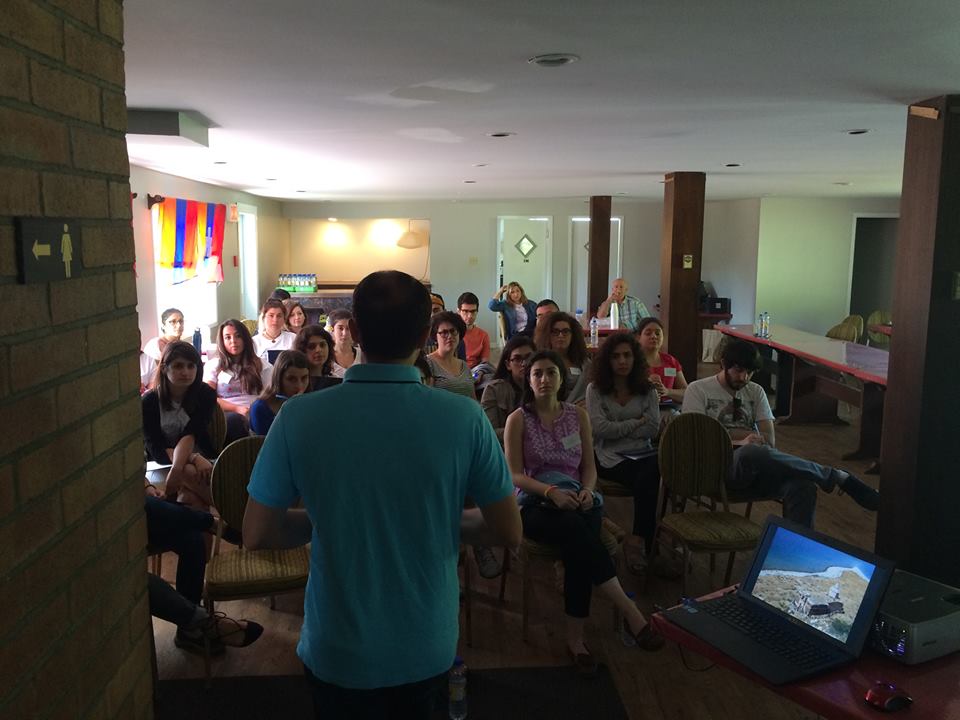
Program Director Khatchig Mouradian welcomes participants
“For 101 years, Armenians in the diaspora and Armenia have tried to preserve their culture in the hopes that one day it will resonate beyond the diaspora and Armenia… Today, that culture is returning to the lands from where it was uprooted, and helping those who are trying to rediscover their identity,” said Mouradian. He noted, however, that “culture is not something that needs to be preserved, but something that is celebrated.”
Continuing his discussion about Islamized Armenians, Mouradian stressed, “Culture is at its best when it is open to experimentation and exploration.” He warned against narrowing down the definition of who is Armenian, and suggested broadening it instead, embracing all those who try to reconnect with their roots. “We need to embrace them for
our own good, not their own good,” he added. In the diaspora, we often take for granted the freedom to learn our language and explore our culture, whereas for some, for example those living in Turkey, it is a challenge. We can learn and be inspired by them, he said.
“If we just try to preserve culture, like pickles, it’s not going to work. It’s about opening things up. It’s about experimentation. That is how we look at ArtLinks. We bring the speakers and workshop leaders that are somehow connected to Armenianness and offer different perspectives together. It’s about bringing people together to think about Armenian culture and identity,” Mouradian said.
Workshop on Film Explores Collaboration
The first workshop of the program was led by filmmaker Talin Avakian, who explored with participants how one can watch a film critically, how to decipher the intentions of the filmmaker, and what constitutes storytelling. She said that even social media platforms like Instagram and Snapchat are ways for individuals to tell their stories.
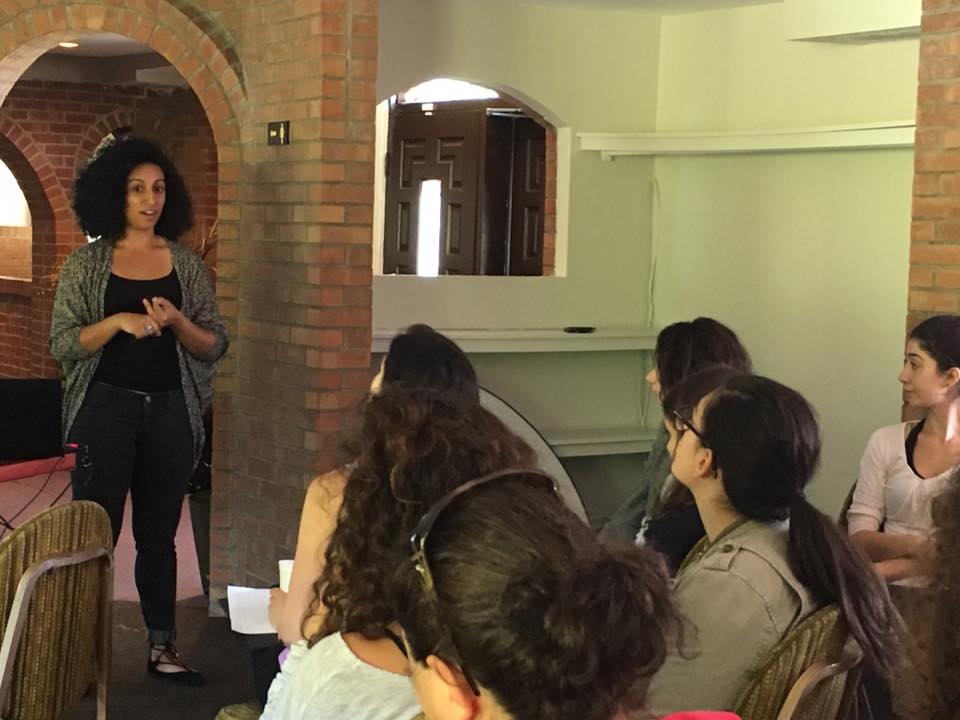
Talin Avakian during the workshop on film (Photo: Nanore Barsoumian)
Avakian spoke about her personal artistic journey, which has taken her from drawing sketches to illustrating cartoons to film. She stressed the importance of the support of her community and family in her journey, and discussed her own struggle to gain confidence in filmmaking.
Avakian also focused on the importance of finding one’s voice. “Your voice might not be so loud and profound at first,” she said, but it is important to learn from your mistakes, while building confidence along the way. In her journey, Avakian discovered that she is a collaborative worker, working with different voices and drawing from the strengths of individuals on a team.
She showed two clips–one a compilation of segments of her work, and one short film titled, “Two Tales of a City.”
She also discussed the history of storytelling and the moving image, and showed a short documentary about “The Birth of Cinema.” She briefly discussed composition, lighting, mis-en-scene, framing, art direction and production design, camera angle, and game.
Avakian’s discussion was peppered with various exercises that demonstrated certain concepts: Participants played games that stressed the importance of collaboration. They engaged in a storytelling exercise using Instagram. Finally, they were tasked with directing a clip over the course of the weekend that would put to use some of the knowledge gained during the workshop.
Avakian is a filmmaker who explores themes of identity, cultural appropriation and struggle, coming of age, and fantasy versus reality in her work. She has produced, shot, edited, and directed numerous films, some of which have made their way around the festival circuit winning awards. She holds a BFA in film/video from the Massachusetts College of Art and Design.
Workshop on Theater Focuses on Space, Movement
Following a break for lunch, the group reconvened for the day’s second workshop led by Vaneh Assadourian, a Los Angeles based actor and director.
Assadourian spoke about the challenges facing those wishing to “make it” as an actor, in terms of the role of agents, personal talents, and demand. “[Acting] is not just about talent but making a product,” she said.
Assadourian shared some of her personal experiences in the acting world, including the role of commercial, theatrical, and film agents; auditions (even tips on what to wear); resume drafting; headshots; and a reel (snippets of one’s work). She also discussed the business side of acting, juxtaposing it with the creative and fun side.
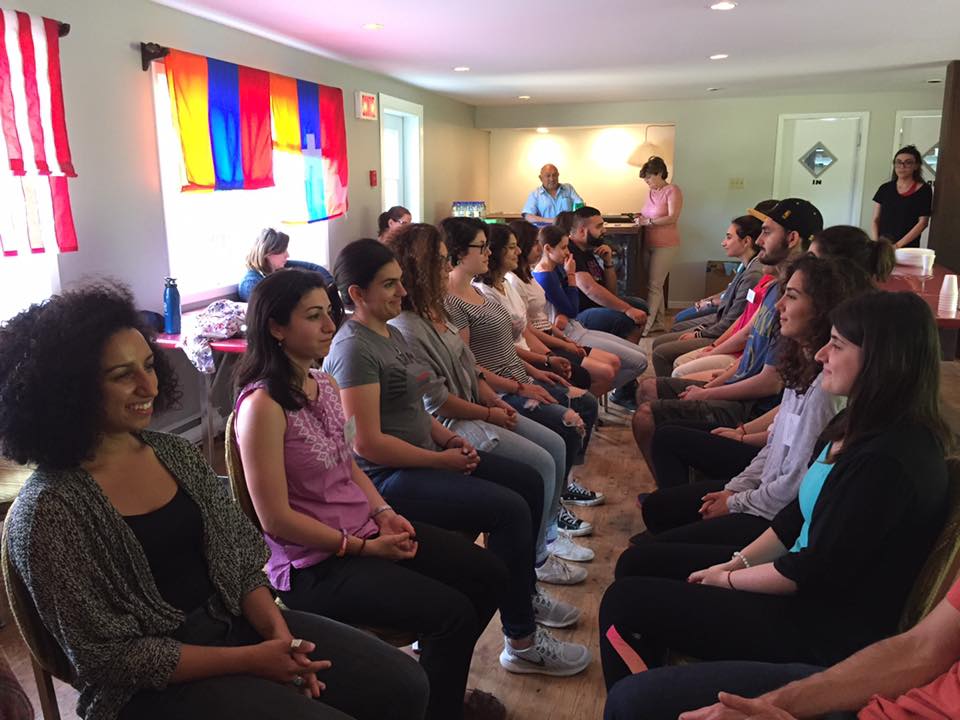
A theater training exercise during Vaneh Assadourian’s workshop
She then touched on some of the training that goes into acting. She escorted the group to the open field across from the house, where she led training exercises for the better portion of the workshop, where participants were forced to be aware of their own bodies, movements, surroundings, and others who they shared that space with.
In 2015, Assadourian earned her B.A. in both directing and acting from UCLA’s School of Theatre, Film, and Television. Recently, she served as the assistant director of the world premiere of SALOME at the Mack Sennett Studios in Los Angeles, and is currently teaching the acting workshop series at the Hamazkayin Cultural Center in Glendale.
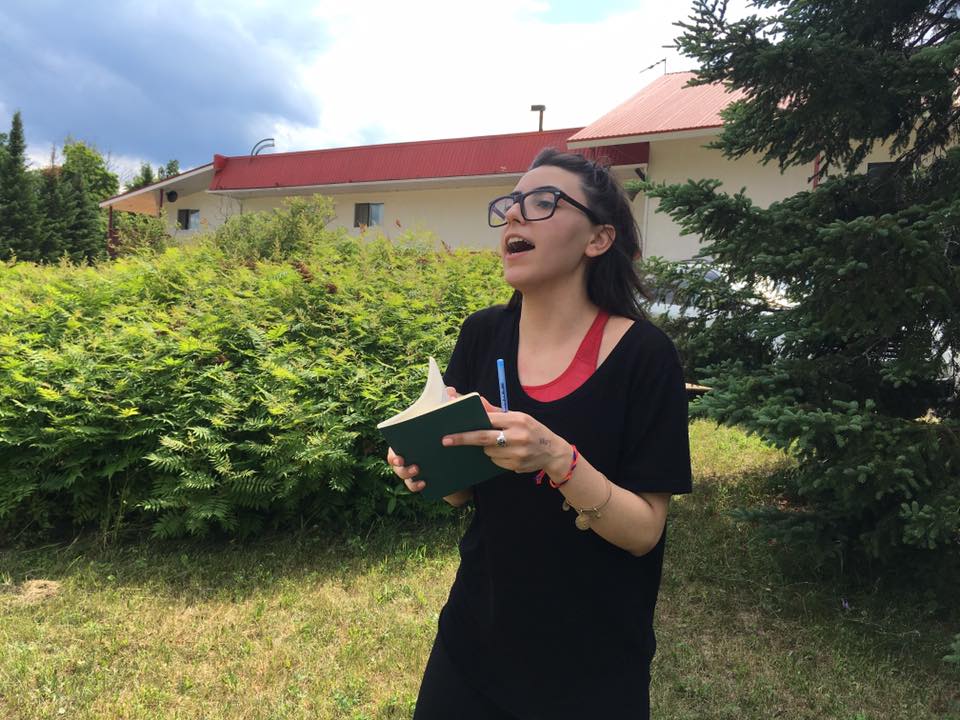
Vaneh Assadourian during leads the theater workshop (Photo: Nanore Barsoumian)
Following the theater workshop, participants and organizers made their way to the nearby lake, where some swam, while others ate ice cream and chatted. One group found itself on unplanned dog-sitting duty, as a lost dog that had wandered to the house earlier in the day had followed them to the lake. Boss the dog enjoyed the company of the group, belly rubs, and ham sandwiches well into the evening when its owner came to pick him up.
Following a power outage and, finally, dinner, which was prepared by resident chef extraordinaire (and stand-up-comedian) Levon Kaprielian, participants dispersed into the game room where they played pool, ping pong, foosball, and cards, and some enjoyed the rooftop Jacuzzi.
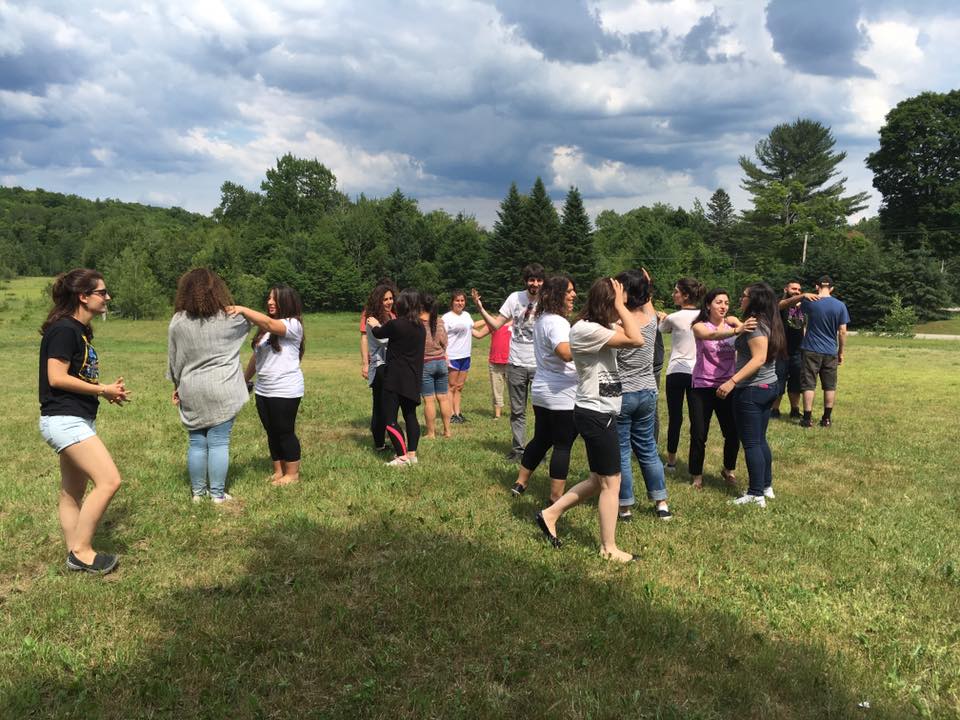
A scene from Vaneh Assadourian’s Theater Workshop (Photo: Nanore Barsoumian)
Saturday morning, participants ate breakfast and gathered to engage in Dr. Kristi Rendahl’s workshop on “Leadership and Culture.” Rendahl lived and worked in Armenia from 1997 to 2002 and visits the country regularly. She currently works with the Center for Victims of Torture as the organizational development advisor to 10 torture treatment centers around the world. Rendahl is also an adjunct professor at the University of St. Thomas and Hamline University in Minnesota, and will teach at ITESO University in Guadalajara, Mexico, in the summer of 2016.
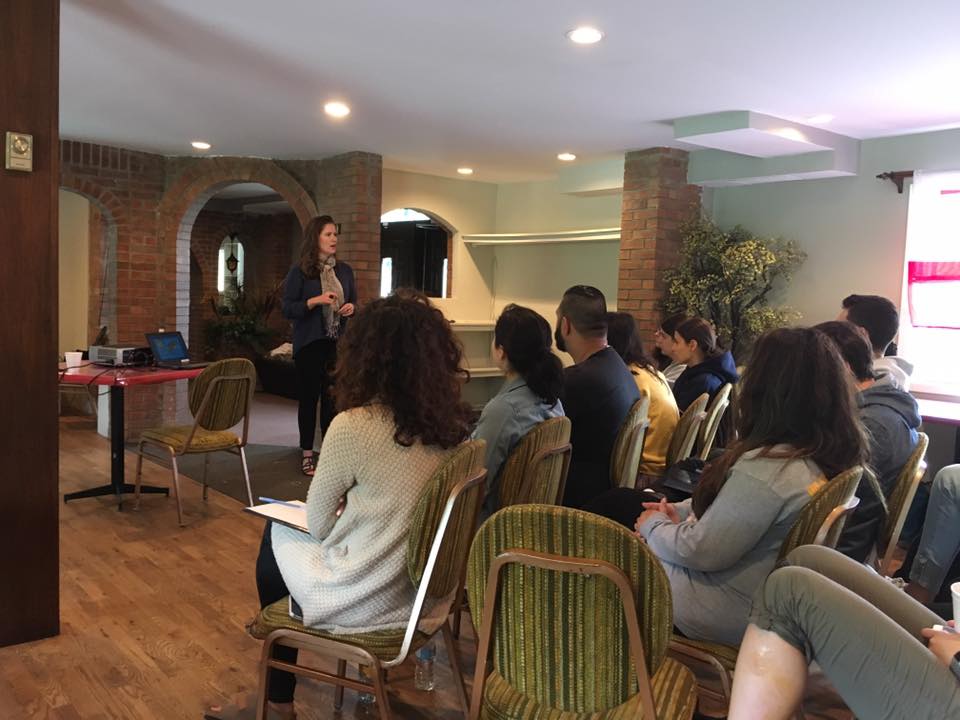
Kristi Rendahl leads the leadership workshop (Photo: Nanore Barsoumian)
Rendahl opened the workshop by greeting and offering introductory remarks in Armenian. She locked the attention of the participants through a brief writing exercise, asking participants to write an acrostic poem using the word “Leadership.”
This was followed by a free-writing exercise. The writing prompt asked participants to begin writing with the following in mind: “My culture is…”; “I see my culture’s influence in the way that I…”; and “Cultures build leaders by…” Some shared their writing with the group.
Rendahl then shared diagrams of the cultural types of the Lewis Model, national cultural models, the Hofstede Model, and a table of low-context and high-context countries and their features. While these models were shared, participants engaged in discussions sharing their observations and thoughts on where Armenian culture is situated within these models. Rendahl also discussed the sociopolitical contexts of various groups (post-colonial, post-communist, post-conflict, and those who fit in one or more of these categories).
Following a presentation of her personal experience leading, observing various leadership styles, and meeting upcoming leaders in various countries, Rendahl divided the participants into groups, offering them guiding questions for a discussion, which participants later shared with the group at large. The discussion centered on leaders the participants knew in their personal lives, how their cultures influenced their leadership styles, and whether they felt their culture could inhibit their leadership.
Rendahl’s workshop was marked by lively and honest discussions.
Writing the Story
The second workshop of the day was led by journalist Liana Aghajanian, who began the workshop by speaking about her journey to journalism. She discussed what journalism means to her, and how it has offered her a mode of witnessing and interacting with the world and strangers.
Speaking about what journalism encompasses, she recalled the saying, “[Journalism is] the first rough draft of history.”
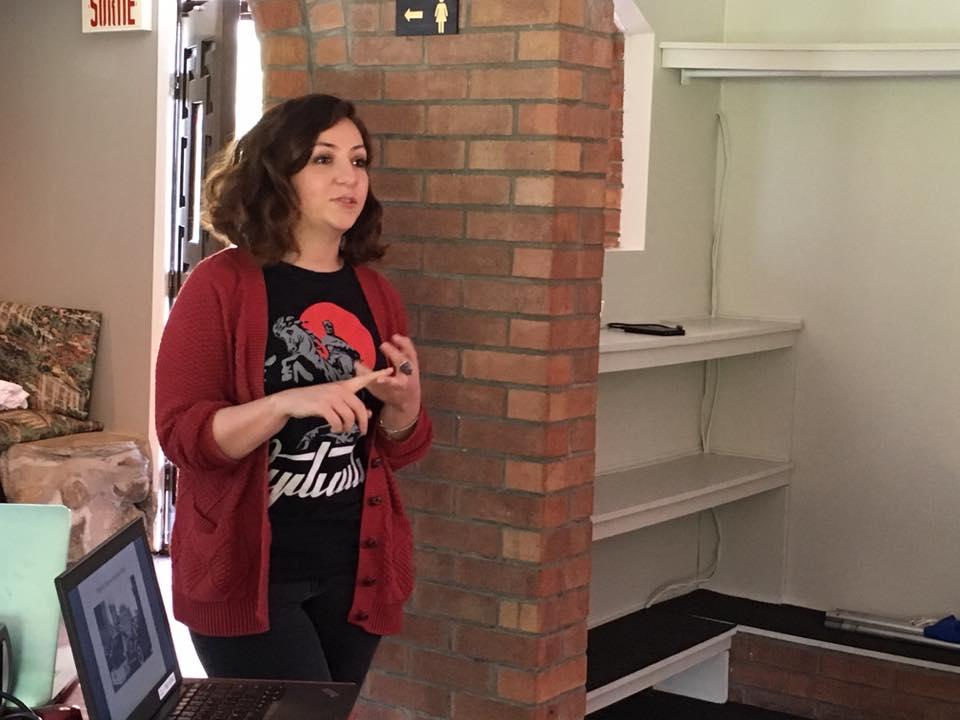
Liana Aghajanian leads the journalism workshop (Photo: Nanore Barsoumian)
Aghajanian discussed what makes something newsworthy: timeliness, proximity, conflict and controversy, human interest, and relevance. She spoke about some of the stories she has written over the years and why she has been attracted to these stories.
She then led a discussion focused on the following questions: Where do you get your news? What news is most important to you? What are stories that you think should receive more media coverage but don’t? These questions led to a robust and open discussion on why some stories receive wide coverage while others do not.
Aghajanian then divided the group into teams, and sent them off to interview organizers on various aspects of the ArtLinks program and write a news item about it. Half an hour later, the teams returned to share their stories, which opened way for further discussions.
Aghajanian is a journalist who explores the issues, people, and places that remain hidden on the fringes of society. Her work has appeared in the New York Times, the Guardian, Newsweek, BBC News Magazine, and Al Jazeera America. She also authors a bi-monthly column for L.A. Times Community News covering the intersection of identity, immigration, and culture, and occasionally runs an online magazine geared towards Armenia and its various diasporas.
In the afternoon, Tamar Chahinian and Nareh Nokhoudian from the Montreal Armenian TV station Horizon arrived. They proceeded to interview workshop leaders and organizers. Nokhoudian stayed on, capturing segments of ArtLinks events as the evening progressed.
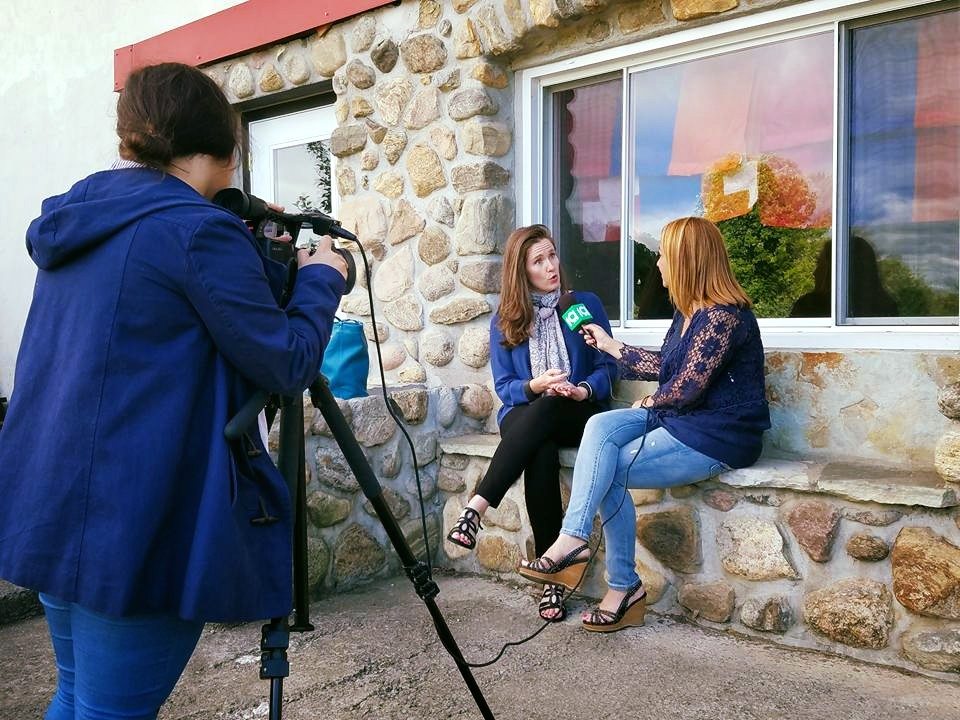
Horizon TV’s Tamar Chahinian interviews Kristi Rendahl (Photo: Meghry Avakian)
A musical evening followed when Beirut-based professional guitarist Megerditch Mikayelian played some numbers on his guitar and presented videos of performances. Participants also shared their own musical talents; some sang, others played the guitar, and still others danced. Outside, a bonfire drew participants. The night evolved into a celebration of dance and music.
Sunday Workshop and Goodbyes
Two brief presentations followed breakfast on Sunday morning, before the final workshop of the program. First, Tamar Donabedian Kuzuian spoke about the Hamazkayin Forum, its history, and its aim. Her presentation was accompanied by a slideshow. She encouraged participants to consider attending the forum.
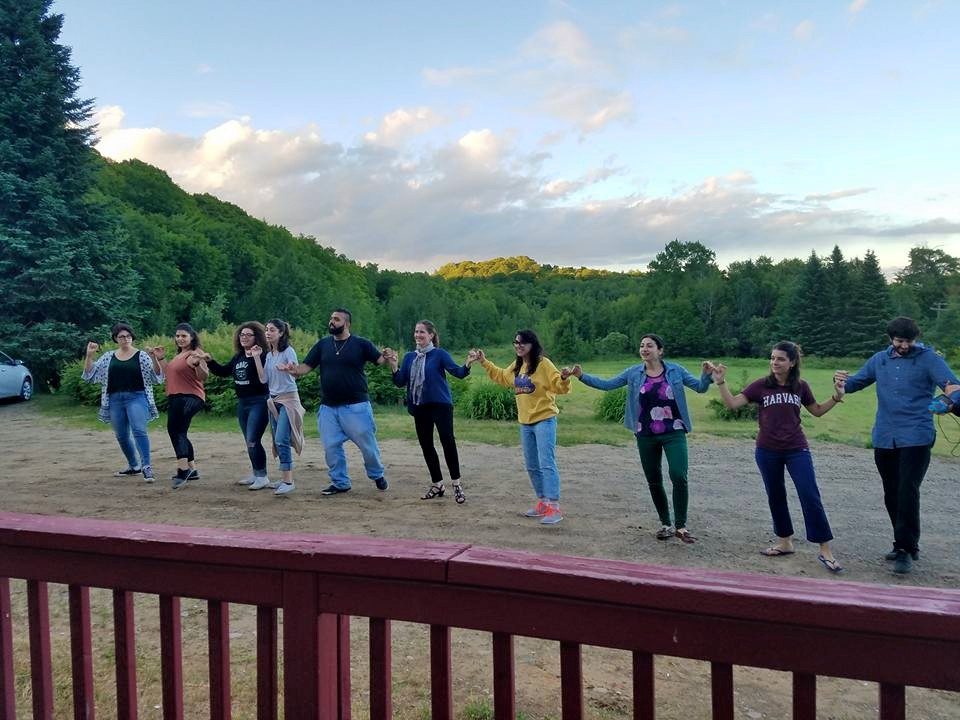
It is always a good time for a Shourchbar! (Photo: Meghry Avakian)
Next, Armenian Environmental Network (AEN) Executive Director Serda Ozbenian and environmental writer and co-manager of the Thousand Leaf Project Lena Tachdjian spoke about the recently launched Thousand Leaf Project, which is sponsored through a partnership with AEN and the American University of Armenia (AUA). The project is in the form of a website that documents (in Armenian and English) plants, herbs, and mushrooms that are used by Armenians worldwide, and their properties. The project encourages people to submit names, recipes, stories, locations, and sustainable harvesting methods of plants and mushrooms that Armenians have come to use (and not just in Armenia). The end goal of the project is to encourage eco-tourism and sustainability. For more information, visit
www.1000leaf.aua.am.
Following these brief presentations, Mheir Karakashian led the workshop on Armenian mythology, covering the various regions of historic Armenia, and the mythologies associated with those areas. Karakashian supplemented his talk with a slideshow that featured images of archaeological discoveries, maps, as well as illustrations and sculptures depicting figures from Armenian mythology. He spoke about the 7,500-year-old Karahunch where people went to observe the stars and worship, Oughdasar where hunters would make a sacrifice for a successful hunt, and the Metzamor Observatory.
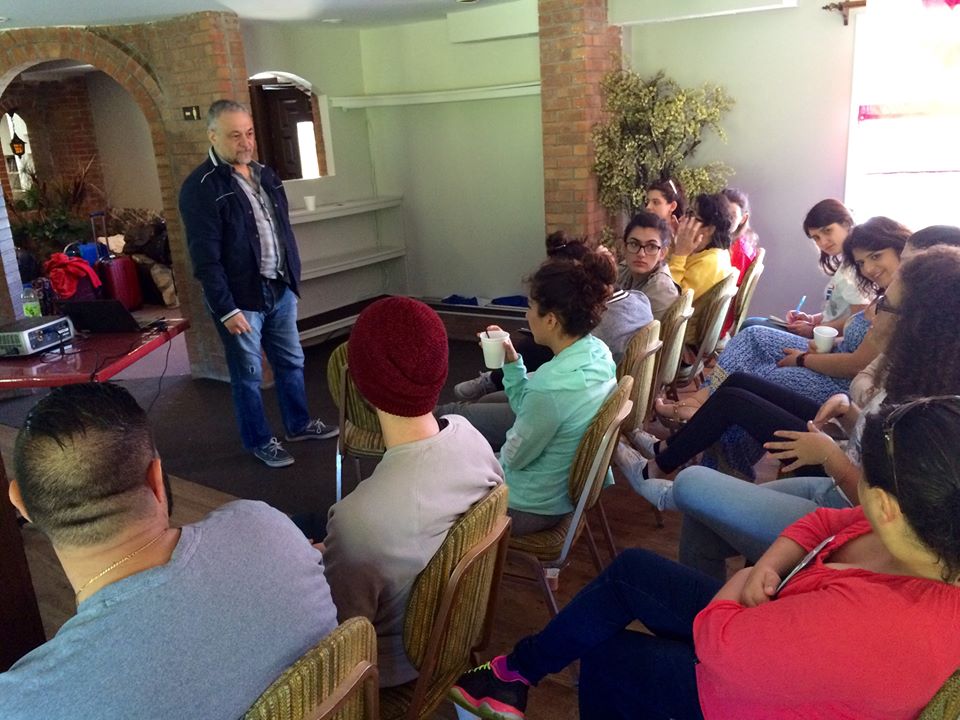
Mheir Karakashian speaking on Armenian Mythology
Karakashian discussed the various symbols that are associated with Armenian mythology, such as the dragon, the snake, the sun sign/symbol of eternity, and the tree of life. Armenians have always had a connection with fire, he stressed. He spoke about the Urartian Kingdom, the Van fortress, and Mher’s Door (the site of ancient inscriptions that is credited to the Urartian King Menua). He profiled the various gods worshipped in historic Armenia (Khalti, Shivini, Warupani, Mihr, Asdghig, Anahid, Vahakn, Nane, Amanor, Vanadur, etc.). He shared some of the myths that have traveled down to us, and highlighted important locations such as Van, Nemrut, Gamakh, etc.
Karakashian also spoke about the origins of Vartavar, the Armenian tradition where individuals splash water on one another. He said that the temple of Asdghig, the goddess of water and love, was located on the shore of the river Aradzani (or Murad), which people would decorate with roses; the tradition stems from there.
Karakashian is a teacher and coordinator of Armenian studies at the Sourp Hagop Armenian School in Montreal. Following his studies in communication arts in Lebanon, Karakashian graduated from the film studies program of Concordia University, specializing in film production. He has also co-authored three volumes of Armenian poetry.
Following Karakashian’s talk, closing remarks were offered by Mouradian, Kahvedjian, and Hamazkayin Central Executive member Viken Tufenkjian.

Participants and organizers before saying goodbye (Photo: Helena Bardakjian)
As a last activity, participants were asked to head outside and line up under the banister for one last group photo. The camera rolled, the participants smiled, and down poured the water! After all, Vartavar was on that very same day!
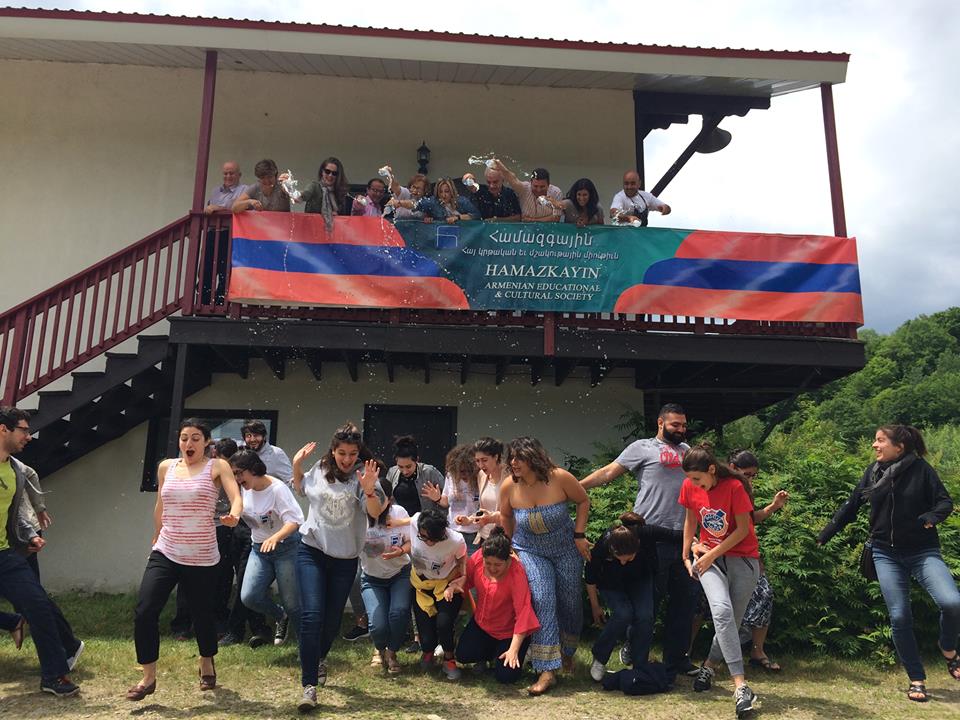
Happy Vartavar!
Hamazkayin Central Executive members Hrair Baronian (United States) and Viken Tufenkjian (Canada) were present during the length of the four-day program, as they were also heavily engaged in the organizing. During the span of the program, following each presentation, Hamazkayin Regional Board members Dzovig Kahvejian (Canada), Manoug Joulkhajian and Zvig Guedikian (West Coast), and Nanore Barsoumian (East Coast) presented the workshop leaders with a copy of Toronto-based photographer Kaloust Babian’s self-titled photo book as a token of gratitude.
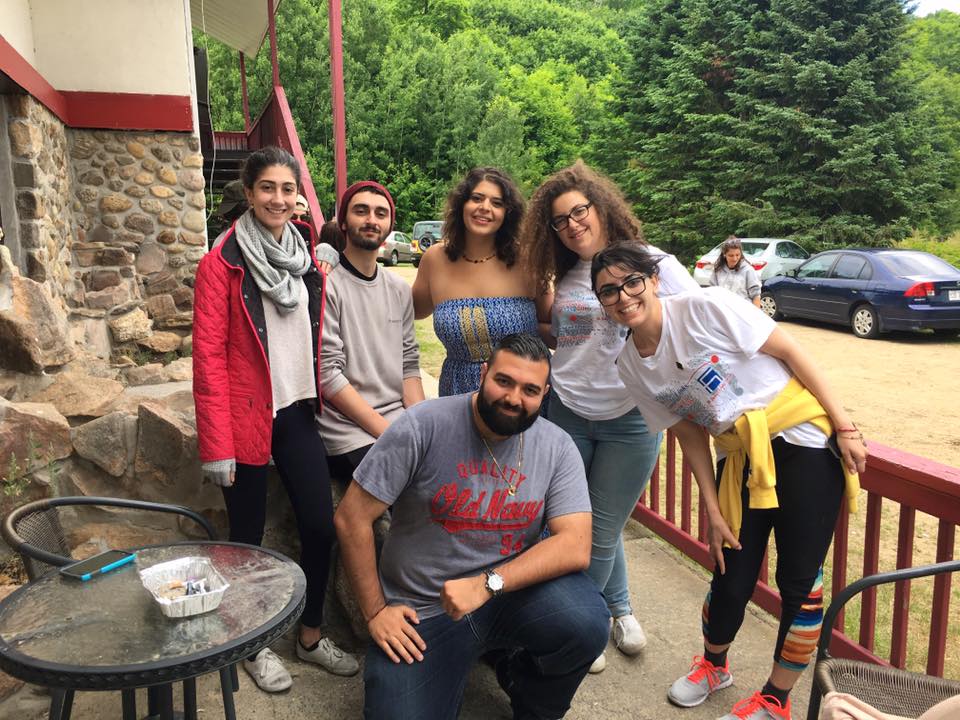
Strangers become friends before the end of the program
“Not only were the workshops at ArtLinks insightful and thought provoking, but they allowed us to critically examine our Armenian identity and culture. We were able to learn a lot and gain perspective. All the participants bonded and we made friendships that will last a lifetime. I feel lucky that I was able to participate in ArtLinks,” reflected Seda Byurat, a participant from Los Angeles.
This was the second annual ArtLinks program. The first took place in New York in the summer of 2015 and featured scholar Talar Chahinian, photojournalist Scout Tufankjian, filmmaker Eric Nazarian, novelist Aline Ohanesian, and actor and playwright Eric Bogosian.
QUEBEC, Canada—Around 20 participants between the ages of 21 and 35 from the United States and Canada arrived at Auberge du Mont-Lanaudi?re in Saint-Gabriel-de-Brandon, Quebec, on June 30 for ArtLinks 2016, a four-day arts retreat organized by the Hamazkayin regional boards of the East Coast, West Coast, and Canada. The program promised to deliver five engaging workshops run by experts in their respective fields covering film, theater, journalism, leadership, and mythology. Participants, workshop leaders, and organizers emerged from the weekend having gained so much more—from newly gained knowledge to an immersion in the arts and, more importantly, an opportunity to engage with others who have an appreciation for the exploration of the arts and of Armenian culture. A group portrait in the field “ArtLinks was incredible—an amazing weekend of great people, limitless conversation, and a reminder that as the future leaders in our communities we can be the beginning of change! This was a weekend that I won’t forget,” said Helena Bardakjian, a participant who hailed from Detroit. Upon arriving at the retreat, the participants were given folders containing information, ArtLinks tees, and a room number. Once everyone had gathered in the cafeteria for the lahmajun and mana’ish dinner, the [...]
QUEBEC, Canada—Around 20 participants between the ages of 21 and 35 from the United States and Canada arrived at Auberge du Mont-Lanaudi?re in Saint-Gabriel-de-Brandon, Quebec, on June 30 for ArtLinks 2016, a four-day arts retreat organized by the Hamazkayin regional boards of the East Coast, West Coast, and Canada. The program promised to deliver five engaging workshops run by experts in their respective fields covering film, theater, journalism, leadership, and mythology. Participants, workshop leaders, and organizers emerged from the weekend having gained so much more—from newly gained knowledge to an immersion in the arts and, more importantly, an opportunity to engage with others who have an appreciation for the exploration of the arts and of Armenian culture. A group portrait in the field “ArtLinks was incredible—an amazing weekend of great people, limitless conversation, and a reminder that as the future leaders in our communities we can be the beginning of change! This was a weekend that I won’t forget,” said Helena Bardakjian, a participant who hailed from Detroit. Upon arriving at the retreat, the participants were given folders containing information, ArtLinks tees, and a room number. Once everyone had gathered in the cafeteria for the lahmajun and mana’ish dinner, the [...]
[img][/img]
More...